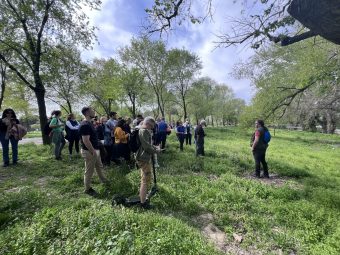A Sunday afternoon on the Zemun Quay was marked by nature, learning, and community spirit. Citizens had the opportunity to spend the day outdoors, learning about the trees that inhabit this riverside area.

The first workshop was organized by the Community for Nature’s Rights Belgrade, aiming to teach Belgraders how to recognize and map trees in their surroundings. The idea is to gradually build collective awareness of the importance of preserving urban nature, while also fostering individual responsibility.
“To protect nature, we must first understand it,” was the key message echoed throughout the workshop. Helping participants in this process was forestry expert Stefan Vukić from the Braničevo Initiative, who introduced them to the most important tree species growing along the Zemun Quay.
Recognizing tree species is not only important for knowledge but also serves as the first step toward their protection. As emphasized during the workshop, some trees are especially valuable and at the same time endangered—whether due to urban development, poor maintenance, or the replacement of native species with more economical hybrids.
According to Serbia’s National Forest Inventory (2008), about 30 percent of the country is forested. The most widespread native species is the beech (40 percent ), followed by oak (25 percent ), which is often found in riverbank areas. However, forests in these zones only cover 22,400 hectares – just 0.001 percent of Serbia’s territory – making them extremely rare and vulnerable. A similar situation exists with poplars, which cover about 48,000 hectares (0.2 percent).
Globally, as much as 90 percent of native forests are under some degree of threat.
More:
- Social Media as a Tool for Monitoring Species in the Era of Climate Change
- Two Trees for Every Child – Love That Grows in Nature
- Tree Planting in the Arctic Could Accelerate Global Warming, Scientists Warn
During a walk and hands-on demonstration, participants learned how tree species naturally arrange themselves from the riverbank inland: white willows dominate closest to the water, followed by poplars, then oaks. Among the highlighted species was the native black poplar, recognizable by its prominent knots.

“It’s also called janj topola or mazer. When you see those irregularly shaped, patterned wooden tables at fairs – that’s black poplar. That’s why it’s become very endangered, and it’s difficult to regenerate naturally,” explained Stefan.
In contrast, there is the Canadian poplar, a hybrid of the American and native black poplar. While it grows quickly and is used in industry for making crates and pallets, it holds little ecological value and often threatens the survival of native species.
As for willows on Great War Island, the dominant species in this area is the white willow, followed by the brittle willow, and many shrubby forms are also present – including crack willow, almond willow, goat willow, marsh willow, and others. It is especially important to note that both willows and poplars have phytoremediation properties – the ability to purify soil and improve environmental quality.
Participants also had the chance to observe poor urban greenery management practices – particularly the “topping” method of pruning. This outdated practice, largely abandoned worldwide, shortens trees’ lifespans and exposes them to additional stress.
The Siberian elm was also spotted on the quay – a fast-growing tree that provides good shade and is used as a windbreak due to its ability to be planted densely.
The workshop demonstrated how crucial it is for the city to reconnect with its own nature – to encourage citizens to observe, recognize, and understand what grows around them.
Katarina Vuinac



